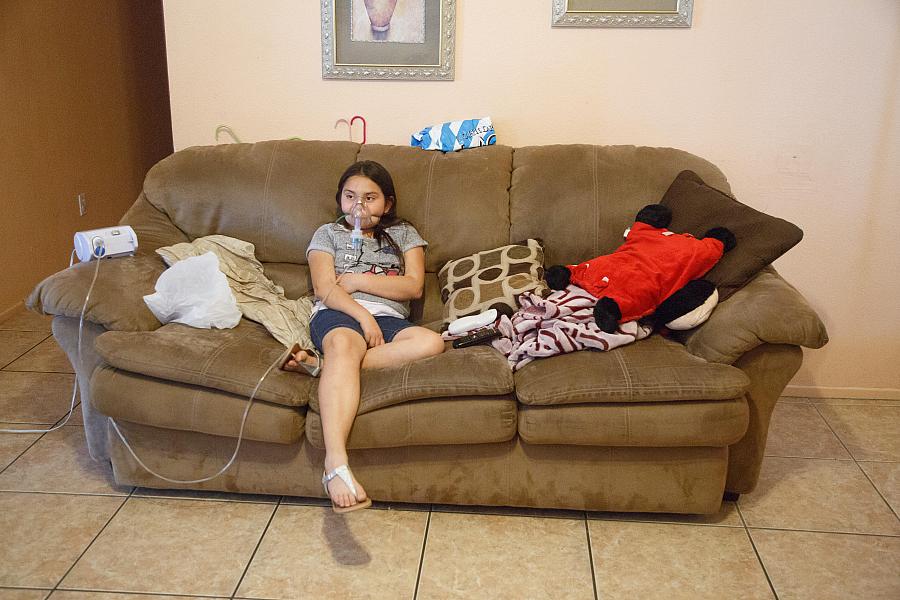Novel collaboration fuels Desert Sun's reporting on health effects of shrinking Salton Sea

Kaylee Pineda uses a nebulizer treatment to prevent an asthma attack before going to her baseball game in Westmoreland, Calif. (Photo by Zoë Meyers/The Desert Sun)
At The Desert Sun in Palm Springs, California, we’ve been reporting for years on the problems of the Salton Sea. It’s a slow-moving environmental crisis that’s progressively getting worse as the lake shrinks — and at the end of this year, the lake is about to start drying up much more rapidly.
The flow of water from the Colorado River that has long sustained the lake is decreasing abruptly in 2018 under a water transfer deal. That will leave tens of thousands of acres of lakebed high and dry over the next decade, sending more toxic dust billowing with the winds into surrounding communities, which are predominantly low-income, largely Latino and plagued by high rates of asthma and other respiratory illnesses.
With this critical turning point approaching, my editor Greg Burton wanted to reveal the sea’s quantifiable problems in new ways, and drive home the importance of the threats posed by the deterioration of California’s largest lake — to people’s health, to an ecosystem that attracts migratory birds, and to a desert economy that relies on tourism, vacation homes and farming.
Burton, who is the paper’s executive editor, brainstormed the idea for a Salton Sea project with our colleague Sarah Day Owen, the Sun’s consumer experience director. As Burton later described the project’s genesis, they felt a need to “tell this story in a radically different way,” combining investigative reporting with virtual reality.
They reached out to USC professor Robert Hernandez, whose pioneering virtual reality (VR) work they admired, and the three of them met at the 2016 Online News Association conference in Denver to explore the idea of teaming up. That conversation at a Denver restaurant laid the groundwork for a partnership and a series of stories.
Over the next several months, I and other journalists from The Desert Sun worked with students from the USC Annenberg School for Communication and Journalism – including both Hernandez’s “JOVRNALISM” class on VR journalism and professor Stuart Sender’s environmental journalism class. In March, the students fanned out around the sea to report stories in 360 video, and we went with them. They interviewed biologists and politicians, a farmer and history buffs, children who are coping with asthma and their parents. We worked together in the reporting and fact-checking, and collaborated on the scripts for the VR stories.
My colleagues and I also produced a four-part series with text, photos and 2D video for The Desert Sun and the USA TODAY Network. The stories examined the nearly 15 years of delays and broken promises since California legislators pledged to “undertake the restoration of the Salton Sea ecosystem,” as well as the state’s latest plan to build ponds and wetlands around portions of the lake to restore bird habitat and combat airborne dust.
Our team produced visualizations showing how the sea is shrinking, and photographers Jay Calderon and Richard Lui captured aerial images using a drone.
Throughout the project, we focused on how the sea’s decline is impacting public health, telling stories about people who live close to the sea and are directly affected by the windblown dust. Imperial County already has the highest rate of asthma-related emergency room visits for children in California, and the asthma crisis is expected to get much worse as larger stretches of lakebed are left exposed around the lake.
In communities near the lake, such as Calipatria and Westmorland, we met many people who are suffering from asthma and allergies.
One of them is Kaylee Pineda, a 9-year-old girl who uses an inhaler every morning before school and who stays inside when the wind kicks up dust.
Another is Griselda Peralta, who retired early after she was diagnosed with asthma. She now spends her days indoors and said she feels like a prisoner in her own home.
“I can’t go outside,” she told us. “As soon as I step out the door, I right away start feeling it.”
Their stories reveal the escalating toll of this unchecked public health hazard, and we hope our collaborative work on this project will help generate more movement toward solutions.
**
Read the series and experience the VR stories: California’s Dying Sea. Also featured on the JOVRNALISM site: Turning Tides of the Salton Sea.

